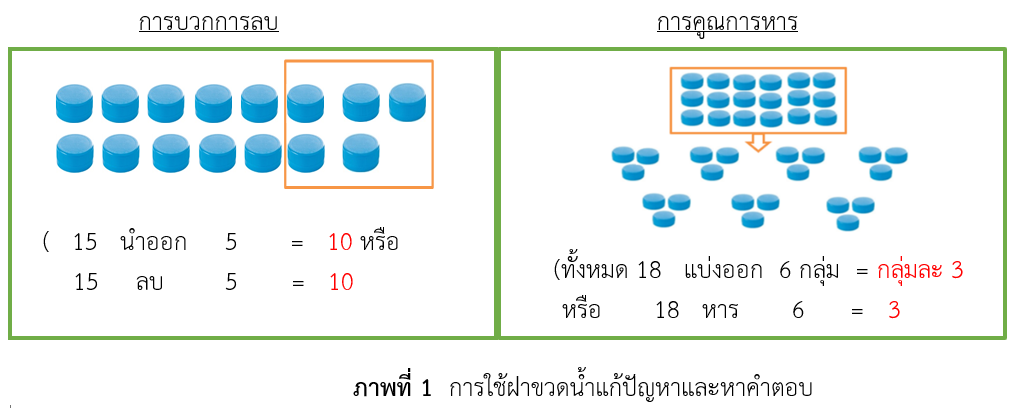การจัดกิจกรรมการเรียนรู้แบบ Concrete-Pictorial-Abstract (CPA) ที่ส่งเสริมมโนทัศน์ทางคณิตศาสตร์ เรื่องการบวก การลบ การคูณ การหาร ของนักเรียนชั้นประถมศึกษาปีที่ 4
Main Article Content
บทคัดย่อ
การวิจัยนี้มีจุดมุ่งหมายเพื่อพัฒนาการจัดกิจกรรมการเรียนรู้แบบ Concrete-Pictorial-Abstract (CPA) ที่ส่งเสริม มโนทัศน์ทางคณิตศาสตร์ และเพื่อศึกษามโนทัศน์ทางคณิตศาสตร์ เรื่อง การบวก การลบ การคูณ การหารของนักเรียน ชั้นประถมศึกษาปีที่ 4 ที่เรียนรู้ด้วยกิจกรรมการเรียนรู้แบบ CPA การวิจัยนี้เป็นการวิจัยปฏิบัติการในชั้นเรียน ผู้เข้าร่วมวิจัย คือนักเรียนชั้นประถมศึกษาปีที่ 4 ของโรงเรียนแห่งหนึ่งในจังหวัดชัยภูมิ จำนวน 40 คน เครื่องมือที่ใช้ในการวิจัยได้แก่ แผนการจัดการเรียนรู้แบบ CPA แบบสะท้อนผลการจัดการเรียนรู้ แบบฝึก และแบบวัดมโนทัศน์ทางคณิตศาสตร์ ข้อมูลที่เก็บรวบรวมแล้วจะถูกนำมาวิเคราะห์เชิงเนื้อหา ผลการวิจัยพบว่า การจัดกิจกรรมการเรียนรู้แบบ CPA ที่ส่งเสริมมโนทัศน์ทางคณิตศาสตร์ เรื่อง การบวก การลบ การคูณ การหาร ควรเน้นการใช้วัตถุสร้างความเข้าใจเกี่ยวกับความหมาย ความสัมพันธ์ และลำดับของการดำเนินการ ได้แก่ การบวก การลบ การคูณ และการหาร แล้วเชื่อมโยงความรู้ไปสู่การสร้างภาพจำลองปัญหาที่มีข้อมูลครบถ้วน เพื่อให้นักเรียนสามารถแปลความหมายของภาพจำลองสู่สัญลักษณ์ได้อย่างถูกต้องแม่นยำ ผลการวิจัยจากแบบฝึกระหว่างเรียนและแบบวัดมโนทัศน์ทางคณิตศาสตร์หลังเรียน มีความสอดคล้องกัน คือ นักเรียนส่วนใหญ่มีมโนทัศน์ถูกต้องสมบูรณ์
Article Details

อนุญาตภายใต้เงื่อนไข Creative Commons Attribution-NonCommercial-NoDerivatives 4.0 International License.
วารสารวิทยาศาสตร์และวิทยาศาสตร์ศึกษา (JSSE) เป็นผู้ถือลิสิทธิ์บทความทุกบทความที่เผยแพร่ใน JSSE นี้ ทั้งนี้ ผู้เขียนจะต้องส่งแบบโอนลิขสิทธิ์บทความฉบับที่มีรายมือชื่อของผู้เขียนหลักหรือผู้ที่ได้รับมอบอำนาจแทนผู้เขียนทุกนให้กับ JSSE ก่อนที่บทความจะมีการเผยแพร่ผ่านเว็บไซต์ของวารสาร
แบบโอนลิขสิทธิ์บทความ (Copyright Transfer Form)
ทางวารสาร JSSE ได้กำหนดให้มีการกรอกแบบโอนลิขสิทธิ์บทความให้ครบถ้วนและส่งมายังกองบรรณาธิการในข้อมูลเสริม (supplementary data) พร้อมกับนิพนธ์ต้นฉบับ (manuscript) ที่ส่งมาขอรับการตีพิมพ์ ทั้งนี้ ผู้เขียนหลัก (corresponding authors) หรือผู้รับมอบอำนาจ (ในฐานะตัวแทนของผู้เขียนทุกคน) สามารถดำเนินการโอนลิขสิทธิ์บทความแทนผู้เขียนทั้งหมดได้ ซึ่งสามารถอัพโหลดไฟล์บทความต้นฉบับ (Manuscript) และไฟล์แบบโอนลิขสิทธิ์บทความ (Copyright Transfer Form) ในเมนู “Upload Submission” ดังนี้
1. อัพโหลดไฟล์บทความต้นฉบับ (Manuscript) ในเมนูย่อย Article Component > Article Text
2. อัพโหลดไฟล์แบบโอนลิขสิทธิ์บทความ (Copyright Transfer Form) ในเมนูย่อย Article Component > Other
ดาวน์โหลด ไฟล์แบบโอนลิขสิทธิ์บทความ (Copyright Transfer Form)
เอกสารอ้างอิง
Angganapattarakajorn. V. (2011). Complete with things you should know for math teachers (in Thai). Bangkok: Charasanitwong Printing.
Hoe, L. N. and Jeremy. T. B. L. (2014). The role of virtual manipulatives on the Concrete-Pictorial-Abstract approach in teaching primary mathematics. The Electronic Journal of Mathematics and Technology, 8(2), 102-121.
Hoong, L. Y., Kin, H. W. and Pien. C. L. (2015). Concrete-Pictorial-Abstract: Surveying its origins and charting its future. The Mathematics Educator, 16(1), 1-18.
Hui, C. S., Hoe, L. N. and Lee, K. P. (2017). Teaching and Learning with Concrete- Pictorial-Abstract Sequence: A Proposed Model. The Mathematics Educator, 17(1), 1- 28.
Institute for the Promotion of Teaching Science and Technology. (2015). Trends in International Mathematics and Science Study 2015 (in Thai). Retrieved 1 February 2020, from TIMSS 2015: from://timssthailand.ipst.ac.th/timss/reports/TIMSS2015summary
Isaraprida, P. (2006). Essential educational psychology (in Thai). Khon Kaen: Klungnanatham.
Kemmis, S., & McTaggart, R. (1988). The action research planer (3rd ed.). Victoria: Deakin University.
Makanong, A. (2003). Teaching and learning (in Thai). Bangkok: Chulalongkorn University Press.
Ministry of Education, Thailand. (2010). Basic Education Core Curriculum B.E. 2551 (A.D. 2008). Bangkok: The Agricultural Co-operative Federation of Thailand.
Pananchai, K. (2018). Eleventh grade students’ conceptual understanding and mental models on chemical equilibrium from learning by using inquiry incorporated with predict-observe-explain technique (in Thai). Journal of Science and Science Education, (1)1, 49-60.
Pattanatrakoolsook, K. (2002). Why should we learn mathematics? (in Thai). Journal of Mathematics, 46, 35-39.


